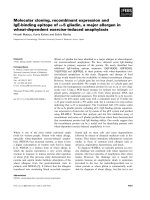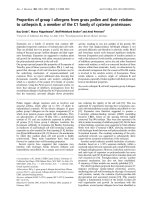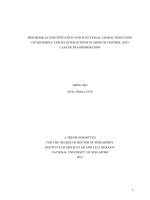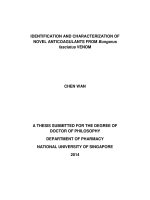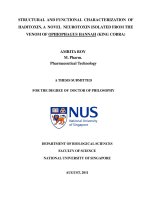Identification and characterization of novel group 5 and group 21 allergens from dust mite and ige binding epitope mapping of blo t 5
Bạn đang xem bản rút gọn của tài liệu. Xem và tải ngay bản đầy đủ của tài liệu tại đây (2.51 MB, 259 trang )
Identification and Characterization of Novel Group 5 and
Group 21 Allergens from Dust Mite
and IgE Binding Epitope Mapping of Blo t 5
Gao Yunfeng
National University of Singapore
i
2007
Identification and Characterization of Novel Group 5 and
Group 21 Allergens from Dust Mite
and IgE Binding Epitope Mapping of Blo t 5
Gao Yunfeng
(B. Eng., ECUCT)
A Thesis Submitted
for the Degree of Doctor of Philosophy
Department of Biological Sciences
National University of Singapore
ii
2007
Acknowledgements:
I would like to express my deepest thanks to
Dr. Chew Fook Tim, my supervisor, for
his invaluable guidance, motivating advices and consistent support throughout this PhD
project.
I would also like to thank Associate Professor Wang De Yun for his valuable
advices, encouragement and kind help.
This project would be impossible without his
support.
I am much obliged with many thanks to Dr. Ong Tan Ching for her kind
discussions on immunology study and the help with statistics study, to Dr. Shang Hui
Shen for sharing his experience of molecular study, to Tay Angeline, Yap Kwong Hsia
and Tiong Louis for all their helps in immuno-array study. It has been great working in
the Allergy and Molecular Immunology Laboratory with Lee Wan She, Wang Kang Ning,
Lim Puay Ann, Jiang Nang, Ong Su Yin, Gan Lydia, Joshi Sairabh, and all other lab
members.
Many thanks also to all the supporting staffs, especially Ms. Joan Choo, Mrs. Chan
Yee Ngoh, Ms. Reena Devi, Mdm. Liew Chye Fong and Mr. Woo Hin Cheow for their
invaluable assistance.
Lastly, my deepest appreciation and love to my family for their unconditional love,
patience and support
throughout these years.
i
List of publications
Publication
Gao YF, Wang DY, Ong TC, Tay SL, Yap KH and Chew FT. Identification and
Characterization of a Novel Allergen from Blomia tropicalis: Blo t 21. J Allergy
Clin Immunol. 2007; 120(1):105-12.
International Conference Abstracts
1.
Gao YF, Wang DY, and Chew FT. Independent co-sensitization not due to cross-
reactivity between paralogous of group 5 allergens from Blomia tropicalis and
Dermatophagoides farinae. 2006. J Allergy Clin Immunol. Volume117, Issue 2,
Supplement 1. Page S119.
2. Bi XZ,
Gao YF and F.T. Chew. Blo t 5, the major allergen from dust mite Blomia
tropicalis, is secreted from the mite stomach and gut epithelial and is associated with
gut and fecal contents. 2005. J Allergy Clin Immunol. Volume 115, Issue 2,
Supplement 1. Page S91.
3.
Gao YF, Bi XZ, Shang HS, Wang DY and Chew FT. Molecular cloning and
characterization of a group 5 paralogue from Blomia tropicalis. 2005. J Allergy Clin
Immunol. Volume 115, Issue 2, Supplement 1. Page S90.
4. Reginald K,
Gao YF, Siew YS, Shang HS and. Chew FT. Cross comparison of the
IgE binding profiles to recombinant allergens from Suidasia medanensis, Blomia
tropicalis and Dermatophagoides farinae using Sera from Blomia- and
Dermatophagoides-Predominant Environments. In: The 61th American Academy of
Allergy and Immunology Annual Meeting, 19 - 24 March 2004, San Francisco, USA.
J Allergy Clin Immunol 113 (2): S228-9.
5. Tay ASL, Shang HS, Bi XZ, Reginald K,
Gao YF, Angus AC, Ong ST, Wang WL,
Kuay KT, Wang DY, Mari A, Chew FT (2005). Component-resolved diagnosis of
house dust mite allergy with a large repertoire of purified natural and recombinant
allergens from the major species of mites worldwide. In: The 62th American
Academy of Allergy and Immunology Annual Meeting, March 2005, San Antonio,
USA. J Allergy Clin Immunology, 115 (2): S164.
ii
6.
Gao YF, Tan X.J, Ong ST, Bi XZ, Shang HS, Wang DY, and Chew FT.
Characterization of two paralogous genes showing identities to Group 5 allergens in
house dust mite Dermatophagoides farinae. The XXIIIst Congress of the European
Academy of Allergology and Clinical Immunology (EAACI 2004), Amsterdam RAI,
Netherlands, 12-16 June 2004.
7. Reginald K,
Gao YF, Lim YP, Chew FT (2004). The expressed sequence tag
catalogue and allergens of dust mite, Suidasia medanensis. In: XXIIIth European
Academy of Allergology and Clinical Immunology Annual Meeting (EAACI), June
2004, Amsterdam, The Netherlands.
8. Loo AHB, Goh SY, Reginald K, Gao YF, Jethanand H, Shang HS and FT Chew
(2004). Validation of the purity of Acarid mite cultures used for Allergen Extract
Preparation and identification of contaminants by ribosomal DNA sequencing via a
PCR-cloning- and sequence homology-based approach. In: The 61th American
Academy of Allergy and Immunology Annual Meeting, 19 - 24 March 2004, San
Francisco, USA. J Allergy Clin Immunol 113 (2): S140.
9.
Gao YF, Tay SL and Chew FT. Identification of group 5 allergens from Suidasia
medanensis. The 9th Biological Sciences Graduate Congress, Bangkok, Thailand, 16-
18 December. 2004.
10. Loo AHB, Tan SPL, Angus AC, Kuay KT, Reginald K,
Gao YF and Chew FT.
Genetic relationship between allergy-causing dust mites: phylogenetic inference from
random amplified polymorphic DNA (RAPD) markers, housekeeping gene (18S
rDNA) and group 2 Allergens. In: The 60th American Academy of Allergy and
Immunology Annual Meeting, 7 - 12 March 2003, Denver, USA. J Allergy Clin
Immunol 111 (2): S162.
Awards:
Best Poster Presenter for the poster presentation entitled:
Gao YF, Tay SL and Chew FT. Identification of group 5 allergens from Suidasia
medanensis. The 9th Biological Sciences Graduate Congress, Bangkok, Thailand, 16-18
December. 2004.
iii
Table of Contents
Acknowledgement
i
List of publications
ii
Table of Contents
iv
List of Figures
xii
List of Tables
xvii
List of Abbreviations
xviii
Summary
xxii
Chapter 1: Literature Review
1
1.1 Hypersensitivity
1
1.2 Allergy-type I hypersensitivity
2
1.3 Mechanism of allergy
3
1.3.1 Dendritic cell
7
1.3.2 Regulatory T cell
8
1.3.3 IgE antibody 10
1.4 Allergen 10
1.5 House dust mites - important indoor source of allergens
11
iv
1.5.1 Biology of dust mite 12
1.5.2 Distribution of dust mite 15
1.5.3 Mite allergens 18
1.6 Strategy to identify dust mite allergen 24
1.6.1 cDNA library screening approach 24
1.6.2 Phage display approach 25
1.6.3 Expressed Sequence Tag - a useful tool to isolate mite
allergen
26
1.7 Recombinant allergens for research, clinical diagnosis and therapy 28
1.8 Objectives of this study 30
Chapter 2: Materials and Methods
32
2.1 Dust mite samples 32
2.2 Cloning of Group 5 and Group 21 allergens and site-directed
mutagenesis of Blo t 5
32
2.2.1 Bacterial strains 32
2.2.2 Identification of Group 5 homologous allergens 32
2.2.3 Computer-based characterization and analysis 33
2.2.4 Phylogenetic tree generation 33
v
2.2.5 RT-PCR method to isolate Der p 21 allergen 34
2.2.6 Cloning of Group 5 and Group 21 allergens in expression vecto
r
and site-directed mutagenesis of Blo t 5
34
2.2.7 DNA sequencing
39
2.3 Genomic study 39
2.3.1 Preparation of mite total genomic DNA 39
2.3.2 Isolation of the genomic organization 40
2.3.3 Southern blotting 42
2.4 Protein expression, purification and CD analysis 42
2.4.1 Expression and purification of wild type and mutant allergens 42
2.4.2 Circular Dichroism spectrum 43
2.5 Immunoassays 44
2.5.1 Patient sera 44
2.5.2 Skin prick test 46
2.5.3 ELISA for quantification of serum specific IgE 46
2.5.4 Immuno-dot blot analysis 47
2.5.5 Competitive cross-inhibition ELISA 47
2.5.6 Effect of temperature, pH and urea on the IgE-binding 48
vi
of Blo t 5 and Blo t 21
2.5.7 Specific IgE-binding to overlapping peptide of Blo t 5 48
2.5.8 Specific antibody production
49
2.5.9 Western blotting
49
2.5.10 Immuno-localization
50
2.5.11 Dust sample collection and processing
50
2.5.12 Measurement of allergen in dust samples
50
2.6 Statistical analyses
51
Chapter 3: Identification and Characterization of a Novel
Allergen from Blomia tropicalis: Blo t 21
52
3.1 Introduction
52
3.2 Results
54
3.2.1 Identification of a novel Blo t 5 homologue (Blo t 21) from B.
tropicalis EST database
54
3.2.2 Genomic organizations encoding Blo t 21 and
Blo t 5
59
3.2.3 Southern blotting
64
3.2.4 Secondary structures of Blo t 21 and Blo t 5
66
3.2.5 Examination of the natural Blo t 21 and Blo t 5
68
3.2.6 Prevalence of Blo t 21 and Blo t 5 sensitization in allergic
rhinitis patients in Singapore
70
3.2.7 Prevalence of Blo t 5 and Blo t 21 sensitization in 72
vii
consecutive individuals attending outpatient allergy clinics
3.2.8 Skin Prick test of Blo t 21 and Blo t 5 in allergic rhinitis
patients
74
3.2.9 Dose-response cross-inhibition of IgE-binding to Blo t 21
and Blo t 5
75
3.2.10 Quantitative end point cross-inhibition of Blo t 21 and
Blo t 5
77
3.2.11 Localization of Blo t 21 and Blo t 5 on sections of mite
body
79
3.2.12 Concentration of Blo t 21 in the house dusts 81
3.3 Discussion 84
Chapter 4: Effect of Temperature, pH and Chemical Denaturant
on Blo t 5 and Blo t 21 IgE-binding
90
4.1 Introduction
90
4.2 Results
92
4.2.1 Effect of thermal treatment on IgE-binding activities of Blo t 5
and Blo t 21
92
4.2.2 Effect of thermal treatment on Blo t 5 and Blo t 21 folding 94
4.2.3 Resistance of IgE-binding of Blo t 5 and Blo t 21 to acid,
alkaline and urea treatment
98
4.3 Discussion 102
viii
Chapter 5: Identification and Characterization of Der f 21: a
Der f 5 Homologue
105
5.1 Introduction
105
5.2 Results
107
5.2.1 Identification of a novel homologue group 5 allergen-Der f
21 from D. farinae EST database
107
5.2.2 Genomic organization of the gene encoding Der f 21 and
Der f 5
111
5.2.3 Southern blot of Der f 21 and Der f 5
116
5.2.4 Secondary structures of Der f 21 and Der f 5 118
5.2.5 IgE-binding of Der f 21 and Der f 5 in consecutive atopic
individuals in Singapore
120
5.2.6 IgE-binding of Der f 21 in patients with onging persistent
allergic rhinitis
123
5.2.7 Dose-response cross-inhibitions of Der f 21 and Der f 5
125
5.2.8 Localization of Der f 21 on sections of mite body
127
5.2.9 Der f 21 and Der f 5 in house dust samples
130
5.3 Discussion
132
Chapter 6: Identification and Characterization of Group 5 and
Group 21 in S. medanensis and Cross Comparison of
a Panel of 11 Group 5 and Group 21 Allergens
135
6.1 Introduction
135
6.2 Results
137
ix
6.2.1 Group 5 and Group 21 allergens in Suidasia medanensis
137
6.2.1.1 Identification of Group 5 and Group 21 in S.
medanensis
137
6.2.1.2 Expression of Sui m 5.01, Sui m 5.02 and Sui m 21
in E.coli
141
6.2.1.3 IgE -binding activities of Sui m 5.01, Sui m 5.02 and
Sui m 21
142
6.2.2 Identification of Ale o 5 146
6.2.3 Expression of recombinant Ale o 5, Gly d 5, Lep d 5 and
Der p 5 in E. coli
147
6.2.4 IgE-binding profiles of 11 Group 5 and Group 21 allergens 149
6.2.5 Cross-reactivity of Group 5 and Group 21 allergens 153
6.2.5.1 Cross-reactivity of Blo t 5 and Blo t 21 153
6.2.5.2 Cross-reactivity of Der f 5 and Der f 21 156
6.2.6 Cross-reactivity of Der p 5 and Lep d 5 159
6.3 Discussion
162
Chapter 7: B Cell IgE-binding Epitope Mapping of Blo t 5
167
7.1 Introduction 167
7.2 Results 169
7.2.1 Identification of Blo t 5 specific epitopes using site-directed
mutagenesis
169
7.2.1.1 Selection of residues for site-directed mutagenesis 169
x
7.2.1.2 Expression of Blo t 5 mutations 171
7.2.1.3 Influence of amino acid substitutions on IgE-binding 172
7.2.2 Identification of Blo t 5 IgE-binding regions using systematic
synthetic peptide
175
7.2.3 Overlapping peptide mapping of rabbit IgG binding regions of
Blo t 5
180
7.3 Discussion
182
Chapter 8: Conclusions and Future Direction
187
8.1 Conclusions 187
8.2 Future direction 193
References
196
Appendix
231
xi
List of Figures
Figure 1.1 Allergy mechanism: (a) sensitization; (b) immediate reaction; (c)
late reaction.
4
Figure 1.2 Control of allergic airway disease by regulatory T cells. 9
Figure 3.1 Nucleotide and amino acid sequence of Blo t 21.
55
Figure 3.2 Predicted secondary structure of Blo t 21 by PredictProtein.
56
Figure 3.3 Multiple alignments of Blo t 21 protein sequence with Der p 21,
Blo t 5, Der p 5, Der f 5 and Lep d 5 protein sequences.
58
Figure 3.4 Alignment of Blo t 21 cDNA and genomic DNA (gBlo t 21.0101). 60
Figure 3.5 Alignment of Blo t 5 cDNA and genomic DNA (gBlo t 5.0101). 61
Figure 3.6 Comparison between the genomic organization of Blo t 5 and
Blo t 21.
63
Figure 3.7 Southern blot analysis of B. tropicalis using Blo t 5 and Blo t 21
probes. A. Hybridization with a Blo t 5 probe. B. Hybridization
with a Blo t 21 probe.
65
Figure 3.8 Expression of recombinant Blo t 5 and Blo t 21 allergens and
their far UV CD spectra.
67
Figure 3.9 Detection of native Blo t 5 and Blo t 21 allergens in the crude
extract. (A). SDS-PAGE gel separating profile of rBlo t 5, rBlo t
21 and B. tropicalis extract. Immuno-blotting images with (B).
anti-Blo t 5, (C). anti-Blo t 21polyclonal antibodies and (D). PBS
(as negative control).
69
Figure 3.10 Bi-plot comparing the specific IgE levels against Blo t 21 and
Blo t 5 assessed by ELISA in sera of 43 allergic rhinitis patients.
71
Figure 3.11
Concordance of the ELISA versus UniCAP system.
71
Figure 3.12 IgE-binding frequencies of B. tropicalis allergens in the B.
tropicalis sensitized individuals (n=97).
73
xii
Figure 3.13 Comparison of the specific IgE levels against Blo t 21 and Blo t 5
assessed by Dot blot immunoassay in sera of 97 B. tropicalis
positive subjects attending outpatient allergy clinics in one and a
half years. (A) Bi-plot comparison of IgE-binding of Blo t 5 and
Blo t 21 (B) Venn diagram showing IgE-binding to Blo t 5 and
Blo t 21.
73
Figure 3.14 Cross comparison between Blo t 5 and Blo t 21 skin prick test
responses among 43 allergic rhinitis patients.
74
Figure 3.15 Dose-response competitive ELISA assay evaluating the IgE
cross- reactivity of Blo t 21 and Blo t 5.
76
Figure 3.16 Immuno-staining of Blo t 21 and Blo t 5 in paraffin-embedded
sections of B. tropicalis. (A). Probed with anti-Blo t 21
polyclonal antibody in longitudinal and sagittal mite sections. (B).
Probed with anti-Blo t 5 polyclonal antibody. (C). Probed with
pre-immune serum. Amg: anterior midgut, Hg: hind gut.
80
Figure 3.17 Competitive ELISA assay evaluating the IgG specificity of Blo t
21 and Blo t 5. (A) Blo t 21 IgG antibody (B) Blo t 5 antibody.
82
Figure 3.18 Blo t 21 and Blo t 5 levels in 71 house dust samples. 82
Figure 3.19 Correlation of Blo t 21 and Blo t 5 levels in the house dust in
Singapore.
83
Figure 4.1 IgE-binding activity of heat treated Blo t 5 (A) and Blo t 21 (B)
in six sera of atopic subjects and one sera of non-atopic healthy
subject.
93
Figure 4.2 Far-UV CD spectrum of Blo t 21 and Blo t 5 at 222 nm recorded
at temperatures from 10 °C to 90 °C.
95
Figure 4.3 CD spectrum of Blo t 5 (A) and Blo t 21 (B) recorded at 20 °C,
50 °C, 70 °C, 90 °C and after cooling down to 20 °C.
97
Figure 4.4 IgE-binding activities of urea, acid and alkaline treated Blo t 5 (A)
and Blo t 21 (B) at different pH ranges from pH 4 to 9.5.
100
Figure 4.5 IgE-binding activities of urea, acid and alkaline treated Blo t 5
(A) and Blo t 21 (B) at pH 2, 7.5 and 12.
101
Figure 5.1 cDNA and deduced protein sequence of Der f 21.
108
xiii
Figure 5.2 Predicted secondary structure of Der f 21 by PredictProtein.
109
Figure 5.3 Multiple alignments of protein sequences of Der f 21, Der p 21,
Blo t 21, Der f 5, Der p 5 and Blo t 5.
110
Figure 5.4 Phylogenetic tree of Group 5 and Group 21 allergens in three
important mite species, Dermatophagoides pteronyssinus, D.
farinae and Blomia tropicalis.
112
Figure 5.5 Pairwise alignment of genomic DNA of Der f 21 and Der f 5.
115
Figure 5.6 Southern blot analysis of Der f 21 and Der f 5 genes in mite
genome.
117
Figure 5.7 Expression of recombinant Der f 21 and Der f 5 allergens and
their far UV CD spectra.
119
Figure 5.8 Comparison of the specific IgE levels against Der f 21 and Der f 5
assessed by dot blot immunoassay in sera of 74 D. farinae
positive subjects attending outpatient allergy clinics over one and
a half years.
121
Figure 5.9 Frequencies of IgE-binding to a panel of 12 recombinant allergens
of D. farinae in 74 sensitized subjects.
121
Figure 5.10 Comparison of the specific IgE levels against Der f 21 and Der f 2
assessed by dot blot immunoassay.
122
Figure 5.11 Bi-plot comparison of specific IgE levels against Der f 21 and
Der f 5 assessed by ELISA in sera of 30 allergic rhinitis patients.
124
Figure 5.12 Dose-response competitive ELISA assay of Der f 21 and Der f 5
using three atopic patients sera. (A) Der f 21 immobilized on solid
phase of ELISA plate. (B) Der f 5 immobilized on solid phase of
ELISA plate.
126
Figure 5.13 Competitive ELISA assay evaluating the IgG specificities of Der f
21 and Der f 5. (A) Der f 21 IgG antibody (B) Der f 5 antibody.
128
Figure 5.14 Immuno-staining of Der f 21 in paraffin-embedded sections of D.
farinae probed with anti-Der f 21 polyclonal antibody in
longitudinal (A) and sagittal mite sections (B). Section probed
with pre-immune sera (C).
129
Figure 5.15 Der f 21 and Der f 5 levels in 76 house dust samples. The solid 131
xiv
line indicated the geometric mean of dust samples.
Figure 6.1 Unrooted phylogenetic tree of 25 S. medanensis cDNAs encoded
Group 5 and its homologues drawn using a bootstrap value of
1000 (DNAMAN).
138
Figure 6.2A Multiple alignments of SM5-1, SM5-2, SM5-3 with Blo t 5 and
Blo t 21.
140
Figure 6.2B Phylogenetic tree of Group 5 homologues in S. medanensis, Blo t
5 and Blo t 21 drawn by Neighbor-Joining method.
140
Figure 6.3 SDS-PAGE profile of purified Blo t 5, Sui m 5.01, Sui m 5.02
and Sui m 21 proteins.
141
Figure 6.4A Frequencies of IgE-binding toward a panel of 11 allergens of S.
medanensis in 82 sensitized subjects.
143
Figure 6.4B Percentage of specific IgE activities of Groups 1, 2, 3, 5, 7, 8, 9
10, 13 and 21 allergen in total IgE of S. medanensis.
144
Figure 6.4 C and D Correlation of IgE antibodies between Sui m 5.01 and 5.02
(C) and between Sui m 5.01 and Sui m 21 (D).
145
Figure 6.5 SDS-PAGE profile of a panel of Group 5 and Group 21 proteins
including Ale o 5, Der p 5, Lep d 5 and Gly d 5.
148
Figure 6.6 Frequencies of IgE-binding toward a panel of 11 Group 5 and
Group 21 allergens from seven species existing in local
environment tested in 118 local mite positive sera visiting
outpatient clinic.
150
Figure 6.7(A) Bi-plot assay of IgE activities of Blo t 5 to Der f 5, Lep d 5,
Ale o 5, Sui m 5.01 and Sui m 5.02.
151
Figure 6.7(B) Bi-plot assay of IgE activities of Blo t 21 to Der f 21 and
Sui m 21.
152
Figure 6.8 Inhibition of Blo t 5 by Group 5 and Group 21 inhibitors from B.
tropicalis, D. farinae, D. pteronyssinus, L. destructor and A.
ovatus using three sera.
154
Figure 6.9 Inhibition of Blo t 21 by Group 5 and Group 21 inhibitors from B.
tropicalis, D. farinae, D. pteronyssinus, L. destructor and A.
ovatus using three sera.
155
xv
Figure 6.10 Inhibition of Der f 5 by Group 5 and Group 21 inhibitors from B.
tropicalis, D. farinae, D. pteronyssinus, L. destructor and A.
ovatus using three sera.
157
Figure 6.11 Inhibition of Der f 21 by Group 5 and Group 21 inhibitors from B.
tropicalis, D. farinae, D. pteronyssinus, L. destructor and A.
ovatus using three sera.
158
Figure 6.12(A) Inhibition of Der p 5 by Group 5 and Group 21 inhibitors from
B. tropicalis, D. farinae, D. pteronyssinus, L. destructor and A.
ovatus.
161
Figure 6.12(B) Inhibition of Lep d 5 by Group 5 and Group 21 inhibitors from
B. tropicalis, D. farinae, D. pteronyssinus, L. destructor and A.
ovatus.
161
Figure 6.13 Neighbor-Joining phylogenetic tree of Group 5 and Group 21
allergens from eight mite species.
164
Figure 7.1 Sequence alignment of Blo t 5 with Der p 5, Der f 5, Blo t 21 and
Der f 21.
170
Figure 7.2 Electrophoresis profile of Blo t 5 mutants on SDS-PAGE gel. 171
Figure 7.3 IgE-binding profiles of Blo t 5 mutants from ten Blo t 5 positive
sera.
173
Figure 7.4 Percentage of subjects whose sera showed reduced IgE-binding
activity to mutants of Blo t 5.
174
Figure 7.5 Overlapping peptides covering Blo t 5 molecule.
177
Figure 7.6
IgE-binding activities of 20 overlapping peptides in 10 Blo t 5
positive sera.
178
Figure 7.7 Number of sera reacting to the overlapping peptide of Blo t 5
(total sera number=10).
179
Figure 7.8 Immuno-response of rabbit polyclonal antiserum to overlapping
peptides of Blo t 5.
181
xvi
List of tables
Table 1.1 Factors influencing T helper cells polarization by dendritic cells. 5
Table 1.2 Abbreviated classification of phylum Arthropoda. 13
Table 1.3 Family and genera of allergy-causing mites that belong to the
Astigmata.
13
Table 1.4. Representative dust mite fauna reported in homes worldwide. 17
Table 1.5 IgE-binding frequencies of dust mite allergens and their biological
properties.
19
Table 2.1 Primers used for generation of expression clones. 36
Table 2.2 List of universal primers used for screening of desired clones. 37
Table 2.3 Primers used for generation of Blo t 5 mutants. 38
Table 2.4 List of primers used for amplification of genomic DNA fragments. 41
Table 2.5 Characteristics of the study patients (n=43).
45
Table 3.1 Polymorphisms of genomic component of Blo t 21.
62
Table 3.2 Polymorphisms of genomic component of Blo t 5. 62
Table 3.3 Quantitative end-point cross-inhibition of IgE-binding to Blo t 21
and Blo t 5 in sera of ten atopic individuals.
78
Table 5.1 Polymorphisms of the genomic component of Der f 21. 114
Table 5.2 Polymorphisms of the genomic component of Der f 5. 114
xvii
List of Abbreviations
Chemical and reagents
AP alkaline phosphatase
BCIP 5-bromo-4-chloro-3-indolyl phosphate
BSA bovine serum albumin
dH
2
0 distilled water
EDTA ethylenediaminetetraacetic acid
IPTG isopropyl-β-thiogalactopyranoside
NBT nitroblue tetrazolium
PBS phosphate-buffered saline
PBS-T phosphate-buffered saline with 0.05% Tween 20 (v/v)
PVDF polyvinyldiflouride
SDS Sodium dodecylsulphate
SDS-PAGE Sodium dodecylsulphate polyacrylamide gel electrophoresis
TE tris-EDTA
Tris Tris (hydroxymethyl)-aminomenthane
Units and Measurements
bp base pair
kb kilo base pair
xviii
kDa kilo Dalton
IU international unit
M Molar
min minute
OD optical density
pH abbreviation of "potential of hydrogen"
rpm round per minute
sec second
V Volt
(v/v) volume: volume ratio
(w/v) weight: volume ratio
µg microgram/s
µl microliter/s
Others
AAAAI American Academy of Allergy, Asthma & Immunology, Inc
APC Antigen Presenting Cell
BLAST Basic Local Alignment Search Tool
CD spectra circular dichroism spectra
cDNA complementary deoxyribonucleic acid
Dc dendritic cell
DNA deoxyribonucleic acid
EST expressed sequence tag
xix
IgE immunoglobulin E
IgG
1
immunoglobulin G, class 1
IgG
4
immunoglobulin G, class 4
IgM immunoglobulin M
IL interleukin
IUIS/WHO International Union of Immunologic Societies Subcommittee/
World Health Organization
MALDI-TOF Matrix-Assisted Laser Desorption/Ionization- Time of Flight
mRNA messenger ribonucleic acid
MHC major histocompatibility complex
MW molecular weight
NCBI National Center for Biotechnology Information
NMR Nuclear Magnetic Resonance Spectroscopy
ORF open reading frame
PCR polymerase chain reaction
PDB Protein Data Bank
pET expression vector (Novagen)
pI isoelectric point
r recombinant
RACE Rapid amplification cDNA ends
RAST radioallergosorbent Test
RNA ribodeoxyribonucleic acid
RT-PCR reverse transcription- polymerase chain reaction
xx
SPT Skin prick test
spp. Speciese
TCR T cell receptor
T
reg
regulatory T cell
TCR T cell receptor
TH T-helper cell
WHO World Health Organization
xxi
Summary
The aim of this thesis is to have a deeper insight and more comprehensive
understanding of mite allergy, focusing on Group 5 and its homologue Group 21
allergens. The study started with characterization of Blo t 21 allergen as B. tropicalis is a
predominant mite species in Singapore as well as in many other regions of the world.
Group 5 and Group 21 allergens in other mite species were also characterized, and finally
IgE-binding areas of Blo t 5, a representative Group 5 allergen, were mapped.
Blo t 21 sensitization is strongly associated with allergic rhinitis. It is a product of
a single-copy gene mainly with α-helical secondary structure, sharing 39% identity to Blo
t 5 protein. When it was evaluated in 43 adult patients, 93% positive response was
obtained by ELISA and 95% by skin prick test. Blo t 21 was found to be the third most
prevalent allergen among 19 B. tropicalis allergens through studies in 97 B. tropicalis
positive individuals. In addition, the majority (>75%) of the Blo t 21 sensitized
individuals were co-sensitized to Blo t 5. Blo t 21 and Blo t 5 were identically distributed
in house dusts, implying co-exposure of these allergens in the population that leads to co-
sensitization of both allergens. Low to moderate degrees of cross-reactivity among Blo t
21 and other Group 5 allergens observed from inhibition studies indicates that Blo t 21
can induce specific hypersensitive responses. Hence, Blo t 21 is a novel clinically
important allergen of B. tropicalis.
The IgE-binding activities of both Blo t 5 and Blo t 21 are stable. Blo t 21 and Blo
t 5 are resistant to heat treatment (up to 90 °C), extreme pH conditions (pH 2 and pH 12)
and chemical denaturation with 6 M urea. The high stability of IgE-binding activites of
Blo t 21 and Blo t 5 explains why these two molecules are so allergenic in B. tropicalis.
xxii
Parallel studies on Der f 21, Sui m 5.01, Sui m 5.02 and Sui m 5.03 consistently
show that Group 5 and Group 21 allergens are important in both predominant mite D.
farinae and less commonly occurring mite S. medanensis. When eleven Group 5 and
Group 21 allergens from seven mite species were evaluated in 118 local mite positive
atopic subjects, Blo t 5 was found the most important allergen. Cross-inhibition studies
revealed the predominant sensitization of Group 5 and Group 21 allergens of B. tropicalis
and D. farinae species and partial cross-reaction to Der p 5, Lep d 5 and Ale o 5 in atopic
individuals.
IgE-binding epitopes of Blo t 5 mapped by both site-directed mutagenesis and
systematic overlapping peptide mapping approaches demonstrate that multiple IgE-
binding epitopes exist throughout Blo t 5 molecule, including N-terminal, Center and C-
terminal of the protein. Majority of the patients respond to multiple epitopes of Blo t 5,
but different individuals react to different epitopes. DLNILERF (98-105) is found to be a
common IgE-binding epitope of Blo t 5.
xxiii
